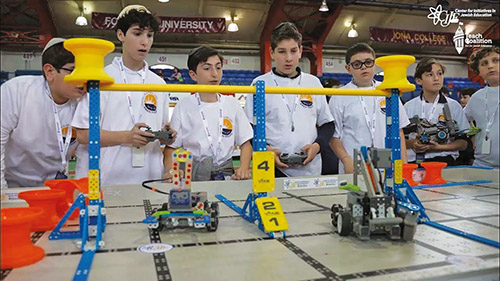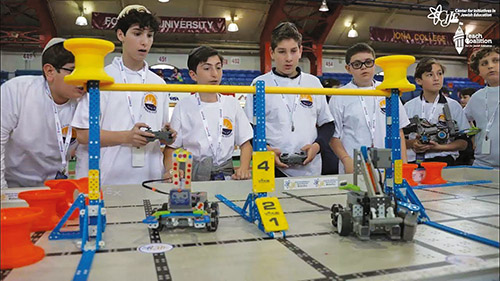
The Center for Initiatives in Jewish Education recently hosted a robotics tournament for day schools to promote STEAM (Science, Technology, Engineering, Arts, and Mathematics) in yeshiva education. Day school students from across the U.S. competed in New York to see whose robots were the best in different categories.
STEAM is an educational approach that incorporates the arts into the more familiar STEM model, which includes science, technology, engineering and mathematics. STEAM programs can include any of the visual or performing arts, such as dance, design, painting, photography and writing. Educational focus has been on STEM fields since the late 20th century, when the ongoing shortage of technology workers began.
Studies have shown that reintegrating art and design into education has increased the happiness and well-being of students. From a business perspective, the major payoffs include better problem-solving skills and increased creativity and innovation. The integration of arts into STEM education and fields may also help encourage more participation by girls in what has been a male-dominated area. STEM programming teaches innovation, creativity, critical thinking, problem solving and collaboration among many other skills proven to lead to success.
In STEAM, arts are included ranging from visual arts, language arts and physical arts to music and more. STEAM focuses
on sparking imagination and creativity through the arts in ways that naturally align with STEM learning.
There is some debate about whether art education should be included in programming promoting science, technology, engineering and mathematics. Some STEM supporters believe that including art takes away from the other core subject matter. Many STEAM supporters believe the arts should not be overlooked and feel that the arts enhance the overall learning experience by adding even more creativity into the mix.
Currently, STEM is the more commonly used terminology, though the debate about STEM versus STEAM is ongoing.
Regardless of one’s preference on STEM education or STEAM education, the key factor remains: using hands-on experiences to teach children the important concepts that will help position them for future success. Hands-on learning allows students to think creatively and use innovation to find unique solutions to common problems.
Students in the modern yeshiva world compete in sports like basketball and hockey and even ice hockey in some schools. There are also some baseball and soccer teams. The annual Sarachek Basketball Tournament sponsored by Yeshiva University is a highlight of the high school sports calendar.
Some schools participate in chess and debating competitions. Lately however, Jewish day schools around the United States have begun to acknowledge and emphasize the importance of STEAM as part of their academic offerings.
As a result of this curricular addition, more than three dozen Jewish day schools and yeshivot from all over the U.S. participated in a recent robotics competition hosted by the Center for Initiatives in Jewish Education (CIJE), in partnership with the Orthodox Union’s Teach Coalition.
Not every child is an athlete nor do they want to be. At the same time STEAM allows students with a different, perhaps more cerebral, skill set to shine. Moreover, there is teamwork, camaraderie and a chance for these kids to work collaboratively. On top of that, it’s a chance for some students who would not otherwise share the limelight to shine.
The Center for Initiatives in Jewish Education (CIJE) was created in 2001 to expand and enhance the education of Jewish day school students in the U.S. It believes that Jewish day school graduates should be prepared to succeed in an ever-changing global society and reach their potential in their future careers and in life. To that end, CIJE seeks to upgrade the technology and programs available to Jewish day schools and yeshivot so that the education these schools provide is world-class.
Today, there are around 200 Jewish schools in CIJE’s network. The education system in many countries around the world is outpacing us. Our kids may fall behind unless schools make some improvements and up the ante. It isn’t necessary for every student to become an engineer or a computer programmer. However, the skills learned and the manner of thinking and problem- solving in these activities can be applied to every occupation.
In addition to classroom-based programming, and in order to highlight the achievements of students who excel in these areas, CIJE hosts tournaments and events across the country, with two main competitions in the fall and spring. Most teams entering these major tournaments come from the tri-state area, but some schools come from as far away as Illinois, Florida and Texas. Schools with larger robotics programs send more than one team. The Frisch School in Paramus for example, had five groups competing in the high school division of the recent robotics tournament..
Groups of elementary, middle and high school students battle for points in improvised arenas and put last-minute fine tuning on their robotic entries, each of which was built and coded by the students themselves. Every entry involved coding and engineering. Students built and rebuilt their robots over and over. On one side of the tournament area middle schools competed to earn points via skills performed by their respective robots. Each team competed in five rounds and the scores were then averaged for an individual total.
In the center, high school teams competed in 2-on-2-style cage matches with more advanced robots. The goal was to score points and block the competition from doing so. The elementary competition was housed on the arena’s other side and was similar to the middle school competition, but with more basic technology and requirements.
This was the first tournament since CIJE launched the competition in 2019 that included elementary school students. Only eight schools received invitations. Nearly three hours of qualifying rounds determined which middle and high school teams made it into the playoffs.
In the end, Brooklyn’s Mazel Day School won first place in the elementary division; teams from Mazel Day School and Brauser Maimonides Academy of Fort Lauderdale, Florida led the middle school competition; and teams from the Hebrew Academy of the Five Towns and Rockaway (HAFTR) in Lawrence, New York and Katz Yeshiva High School in Boca Raton, Florida won the high school title.
This was an opportunity for students to come together in a program that supports teamwork, critical thinking, working hard and overcoming challenges, and it’s an opportunity to showcase a team activity that is not always sports
Rabbi Dr. Wallace Greene is a former day school principal and administrator.













